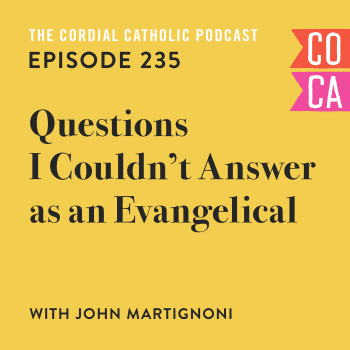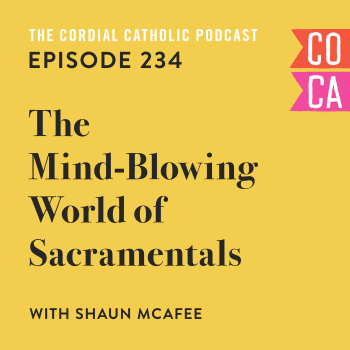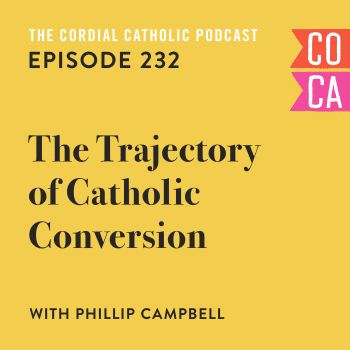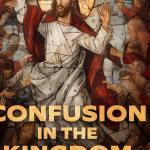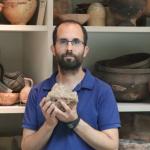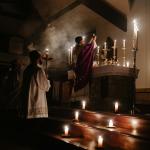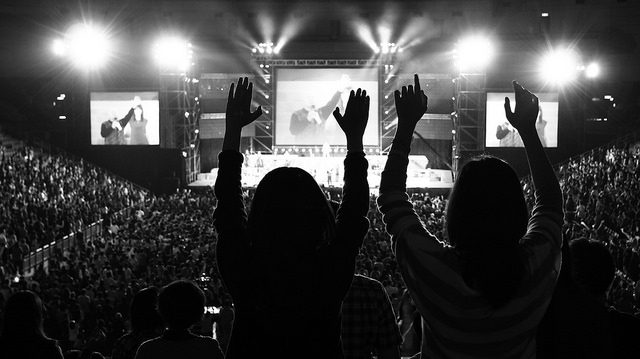
As an Evangelical convert to Catholicism I’ve been deeply interesting in the growing movement within the Evangelical church back towards the ancient liturgies of the church. It is a longing, an urgency, which I felt strongly. It contributed a great deal to my decision to become Catholic.
The idea that worship is not something we need to reinvent; that worship isn’t something which we tailor to suit ourselves. That worship isn’t just singing but something which God clearly laid out for us in Scripture and Tradition following a plan that’s thousands of years old. A way of reaching up and out to God.
Something transcendent.
So when Evangelicals like James K. A. Smith and Jonathan Aigner, my colleague here at Patheos, call for a rejection of the way that some denominations worship I have to agree.
As an Evangelical, “worship” was the time in a Sunday morning service where we sang songs to God.
(Sometimes we sang songs to ourselves about God.)
(Sometimes we just sang songs about ourselves.)
Worship, at any rate, was a very particular part of a Sunday morning services; more or less important than the pastor’s sermon, depending on the denomination.
But in the ancient, liturgical church, worship has always meant much more then that—with roots reaching back into the Old Testament.
For the ancient Israelites, worship of God meant a high priest entering the Holy of Holies in the Temple. The priest would, in regular intervals, present items before the presence of God, items like bread or the blood of sacrificed animals, which would then be imbued with the presence of God.
The bread, coming face to face with God like Moses on the mountain, would shine with the presence of God.
But when Jesus died and the veil in the Temple was torn the wall between man and God’s presence was ruptured. No longer would priests be needed to go into the Holy of Holies and bring out God’s presence—that presence, the real presence of God—was now immediately accessible to all.
Thanks to Christ’s work on the cross.
No longer would the high priest need to wear a breastplate with twelve glowing gems—representing the twelve tribes of Israel—as he entered the Holy of Holies but the twelve tribes could enter themselves.
No longer would the bread shine with the presence of God but, through incredible act of mercy, the bread would become God to be carried out to the people.
In the ancient liturgies of the church this is properly understood. In the Catholic Church, our liturgies stretch back to this same Old Testament worship in the Temple while looking forward to the picture of Heaven St. John gives us in the Book of Revelation.
What the liturgies of the Church do, properly, is to unpack all of this for us.
What the liturgies intend to do is to conform us to best reflect God: the glowing bread. As people of the New Covenant, our liturgical worship is intended to help us to become more familial. To look more and more like our true selves as part of the Family of God. To become more and more swept up in this cosmic romance.
The ancient liturgies of the Church are meant to make us like Christ.
(And this is fundamentally different than just singing.)
In the Catholic tradition, as part of the Mystical Body of Christ, we are also participating in Christ’s work in Heaven. So when Revelation pictures Christ, at the right hand of God the Father, pleading for mercy for his people, we participate in this same act at every single Mass. When we pray, “May our sacrifice and yours being pleasing to you,” it may sound strange and ancient to our post-mondern ears—it may sound downright pagan to an Evangelical—but what we are saying, as members of Christ’s Body, is exactly what Christ in Heaven says to God the Father.
Christ is offering up Himself to Himself in perpetuity. It’s perfect self-giving love. And we are utterly blessed beyond belief to be participating in this same act as part of the same Body.
That is the purpose of the liturgy. And that is worship, at its core.
And that is, at its core, a love story.
The Catholic Church and its ancient liturgy understands worship as a kind of romance. Christ, in the Trinity, gave Himself up to Himself. That is the ultimate expression of love. And, as members of Christ’s Mystical Body, the Church understands that this is what we do in worship.
As Christ’s body we give ourselves up to God, through Christ’s sacrifice being re-presented over and over and over again before God. And in the same way that practicing charitable acts will slowly create in me more authentic feelings of charity, as we celebrate the liturgy we become, bit by bit, more fully incorporated into that self-giving, Trinitarian love triangle.
And this is fundamental to understand.
Because Evangelicals like Aigner are right: our worship shouldn’t be about mustering up feelings of emotional love towards an invisible God. Or even mustering up love towards one another. These feelings are fine but the ultimate purpose of worship is so much more.
Liturgical worship, as the ancient churches understood from the beginning, is a divine love song. It is the Mystical Body of Christ, of which we are blessed to be a part, presenting itself back to God in the ultimate act of love. It is teaching us to love. It is making us more and more like God by presenting us with both a mirror to look into and an example toward which to strive.
And, honestly, in a world as obsessed with self-love as ever God’s antidote—the liturgy of the Church—could not be more timely.








